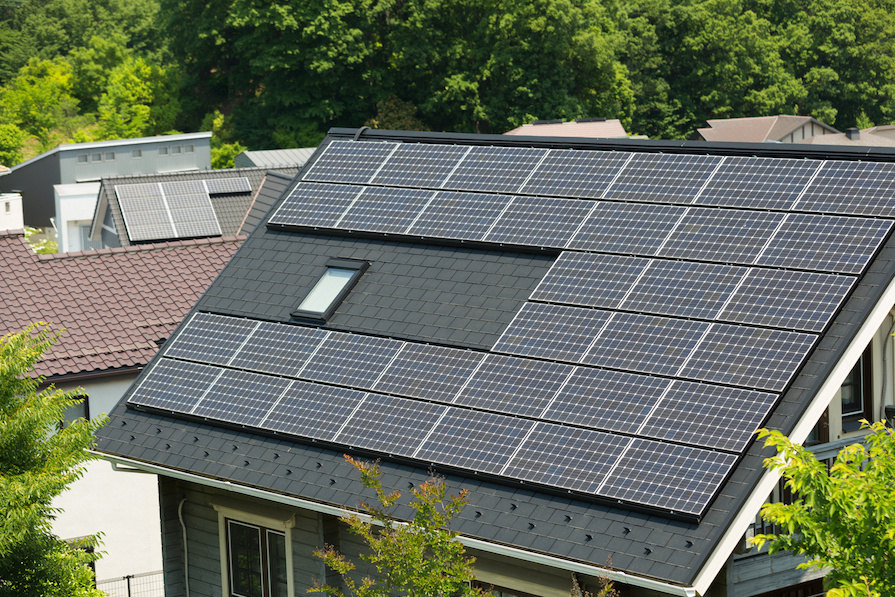In an era characterized by a growing environmental consciousness, individuals and communities are increasingly turning to renewable energy sources to power their homes. Among the most promising and accessible options available, solar panels stand out. This article delves into the utilization of solar panels for tiny houses, exploring their capacity to fully power a household, energy requirements, solar roof costs, panel sizes, and the process of installing solar panels on roofs.

Solar Panels for Tiny Houses
Tiny houses have emerged as a sustainable and minimalist housing solution, designed with efficiency in mind. Solar panels seamlessly align with their eco-friendly ethos, offering a reliable source of clean energy. This makes them an ideal choice for those seeking to live off the grid or reduce their carbon footprint.
The compact size of tiny houses means they require fewer solar panels to meet their energy needs. Furthermore, the mobility of tiny houses allows owners to position them strategically for optimal sunlight exposure, maximizing energy production. This flexibility makes solar panels an excellent choice for tiny house dwellers striving for energy independence.
Can Solar Panels Power an Entire House?
Solar panels have made significant advancements in terms of efficiency and power generation. In many cases, solar panels can indeed power an entire house, subject to specific conditions. The suitability of solar panels for powering a house hinges on factors like the size of the solar panel array, the house’s location, and the household’s energy consumption.
To ascertain if solar panels can meet your entire household’s energy needs, you must calculate your energy consumption in watts. This calculation should encompass appliances, lighting, heating, and cooling systems. On average, a typical American household requires approximately 10,000 to 12,000 watts (or 10 to 12 kilowatts) of solar panels to fulfill its energy demands. It’s important to note that adopting energy-efficient appliances and practices can reduce this requirement.
Solar Roof Costs
The cost associated with installing solar panels on your roof can fluctuate widely based on factors such as the size of the solar panel system, your geographical location, and available incentives or rebates. In recent years, solar panels have become more affordable, rendering them a viable option for many homeowners.
Solar roofs, also known as solar shingles or solar tiles, offer a more integrated and aesthetically pleasing alternative compared to traditional solar panels. However, the cost of solar roofs is typically higher than that of conventional solar panels due to their specialized design and installation requirements. Nonetheless, their ability to seamlessly blend with the existing roof can offset some of these expenses.
Solar Panel Sizes
Solar panel sizes exhibit variations, and selecting the appropriate size for your home hinges on your energy requirements and available roof space. Typical residential solar panels are generally around 65 inches by 39 inches and produce an average of 300 to 400 watts of electricity. Larger panels can generate more power, but they may not be suitable for smaller roofs or areas with limited sunlight exposure.
It’s crucial to consult with a solar installer to determine the optimal panel size for your specific circumstances. They can assess your energy needs and available roof space to recommend the most efficient solar panel size and layout.
Home Power Systems
Home power systems that incorporate solar panels typically encompass additional components, including inverters, batteries, and monitoring systems. Inverters play a vital role in converting the direct current (DC) generated by the solar panels into alternating current (AC), which your home can utilize. Batteries store excess energy for use during overcast days or at night, ensuring a reliable power source even when the sun isn’t shining. Monitoring systems empower homeowners to track their energy production and consumption in real-time, aiding in informed decisions about energy usage.
Installing Solar Panels on Your Roof
The installation of solar panels on a roof is a precise and technical process that should be carried out by trained professionals. Here is a simplified overview of the installation steps:
- Assessment: A solar installer evaluates your roof’s condition, orientation, and shading to assess its suitability for solar panels.
- Design: The installer crafts a customized solar panel system tailored to meet your energy needs and roof space.
- Permits: Necessary permits and approvals are obtained from local authorities.
- Installation: Solar panels, racking systems, and inverters are expertly installed on your roof. This process typically takes several days.
- Connection: The solar panel system is linked to your home’s electrical system.
- Inspection: A final inspection is conducted to ensure the system adheres to safety and quality standards.
- Activation: Once the system passes inspection, it is activated and begins generating electricity.

Solar panels present a viable and sustainable solution for powering homes of all sizes, including tiny houses. They hold the potential to reduce energy costs, decrease reliance on fossil fuels, and contribute to a cleaner, greener future. As solar technology continues to advance and become more affordable, more households are likely to embrace this eco-friendly energy source, propelling us toward a more sustainable future.











